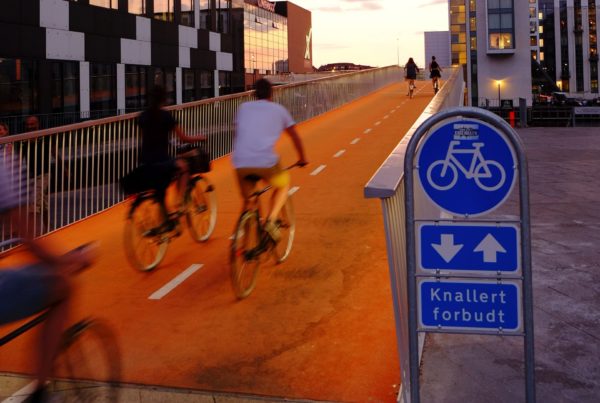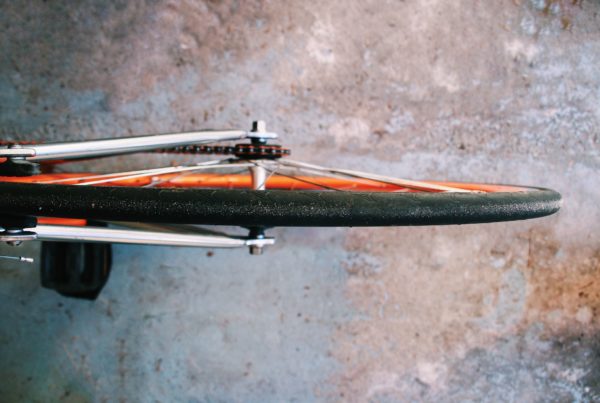This article was written with Miles B. Cooper and first published in the July 2014 issue of Plaintiff magazine (plaintiffmagazine.com).
As more of us rely less upon cars for getting around town, the safety of cyclists and pedestrians becomes more of an issue
My family and I live in San Francisco’s geographic center, where we can walk to almost everything. Within a five- to ten-minute walk we can visit various parks; pick up our dry cleaning; go to the post office, the library, the movie theater, or a cafe; shop for fresh produce at the farmers’ market and numerous stores; or enjoy a night out (although with two young children that last entry is rare indeed). We can do all of this without using a car. Plus, we have the added benefit of fresh air and exercise. What’s not to like about that?
When we need to get somewhere more quickly, or get to more removed parts of the city, we may combine public transportation with our walking. We also rely on bicycles to grocery shop, take our two-year-old to swim classes across town, and explore the city. Our son has been across the bay on numerous occasions with his dad, using a combination of BART and a bicycle. Walking, cycling and public transportation provide complete freedom from a car-oriented lifestyle. We enjoy that freedom.
It’s not that we don’t have a car. We do. We’ve managed to get by with one late-model two-door, which we find we take out less and less often, despite having two young children. The car is used primarily for out-of-town excursions, or for picking up large and heavy items.
We don’t miss driving. And the kids seem to enjoy our chosen modes of transport (“Train! Train! Train!” says our two-year-old).
But protecting loved ones while cycling or walking in the city is as much, if not more, of a concern as being in a car. You don’t have tons of metal protecting you if another driver is negligent. It can make for scary times with the hustle and bustle of city life – especially with ever-more-distracted drivers who may be assisting children with a DVD player in the back seat, looking at their GPS for directions, or texting a friend about the night’s plans. This makes it quite dicey to be a pedestrian or cyclist.
When I say dicey, I have in mind the five- and six-point intersections located all over our neighborhood. We live 100 yards from a six-point intersection. Traffic crossing the intersection consists of pedestrians, cyclists and various types of motorized transport. Drivers often seem confused about where to turn and when. It results in chaos. One never feels particularly safe when stepping into the crosswalk. Being in a car to cross the intersection doesn’t guarantee safe travel, either. We hear occasional honking, then crunches, from our window. Cars do provide more protection, though, when something goes wrong.
Rather than rely on cars as the only form of transport because other modes are too dangerous, we’d like to see conditions made safer for those who enjoy being less reliant on cars. One step along that path is for drivers to be held accountable for their actions.
This issue of Plaintiff addresses some of the questions attorneys may face when clients are injured by cars while walking or cycling. The articles discuss ways in which plaintiffs’ attorneys may prosecute these cases, and thereby assist in making it safer for pedestrians and cyclists on the city streets. One article discusses the comparative fault of a pedestrian, and how to handle it when presenting to a jury. Another article addresses the important elements of evaluating bike cases, and how to spot the ones that will likely be uphill battles. The articles provide helpful information for representing clients who have been injured due to defective bicycle products or dangerous conditions of public property.
We also have included an article on Vision Zero – a program recently adopted by San Francisco which takes a holistic approach to reducing and hopefully eliminating bicycle and pedestrian fatalities. And finally, our guest columnist for Back Story this month discusses LA’s experiment with prosecuting malicious drivers who menace cyclists.
My husband, Miles Cooper, is our guest co-editor for this month’s issue. I asked Miles for his input with this issue because of his enthusiasm for cycling, and his passion for helping those injured while cycling or on foot. We’re excited to have put together this first-of-its-kind issue. We have some great subject-matter experts as authors. Their thoughts can help everyone who handles these types of cases.




